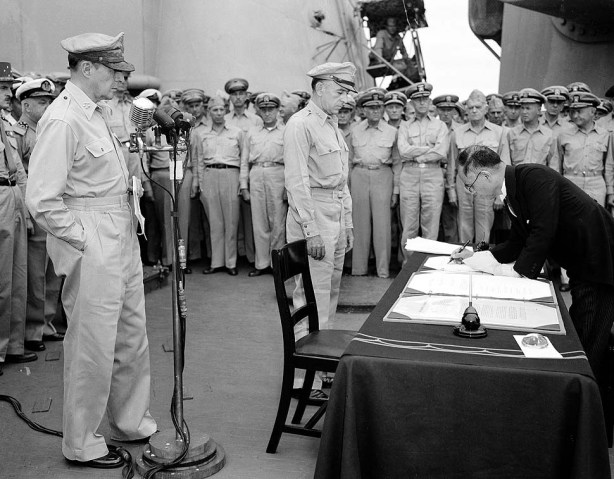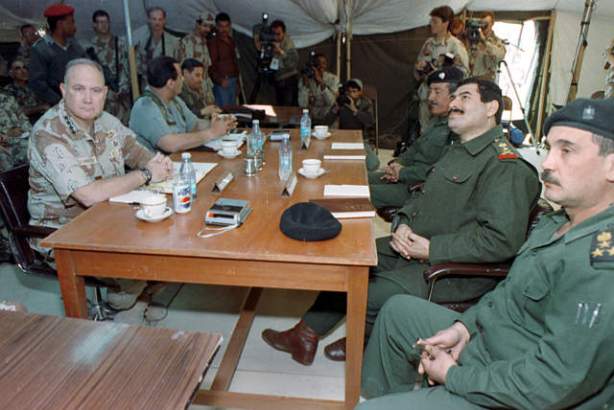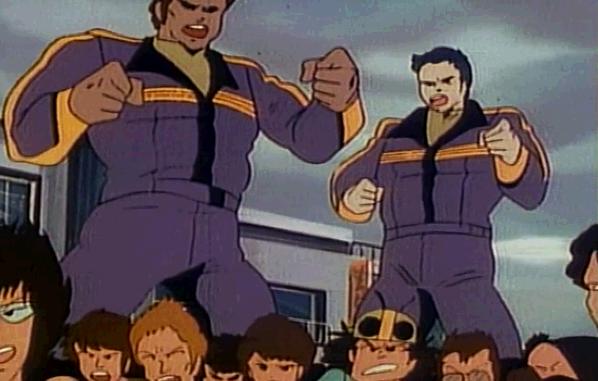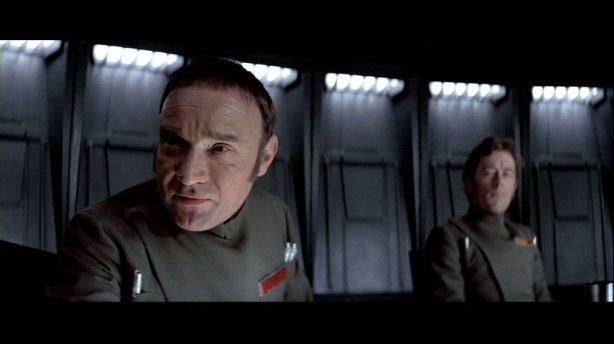Editor’s Note: Today’s guest post comes from repeat contributor Jon Jeckell, who previously wrote about the Jedi Way of War.
Two of the most successful Western epics conclude with a triumphant victory after the elimination of the enemy leader. The literary versions (at least the extended stories) betray some doubts about these seductively easy victories and hint that the authors understand war better than the movies indicate. The movie version of the galactic civil war in Star Wars abruptly and cleanly ends with the death of Emperor Palpatine, and the subsequent rapid collapse of Imperial command and control and other critical systems. Similarly, Middle Earth literally swallows up the entire enemy host in The Lord of the Rings after the demise of Sauron when the One Ring is unmade.1 Both of these wars finish like a game of chess: the pawns become completely irrelevant after the destruction of the enemy king.2
Star Warsis especially egregious in using this theme. The combined Naboo forces win an abrupt victory over the Trade Federation at the end of The Phantom Menace when Anakin Skywalker destroys a single enemy battleship (with a single, random shot), bringing down the command and control network, causing every single Battle Droid to simultaneously go limp. Similarly, Revenge of the Sith essentially ends when the Emperor issues Order 66, and usurps command of the entire Clone Army with a single phrase.3 As for the Separatists, Palpatine already controls that army and merely needs to liquidate his accomplices, who are all conveniently assembled in one location and have the same highly centralized authority, so their organizations effectively die with them. A New Hope ends with the destruction of the single powerful, but brittle weapon system—the Death Star—through a critical vulnerability emblematic of the dangers of over-integration and lack of resilience.
To be fair to George Lucas, paranoid dictators like Stalin, Hitler, and Emperor Palpatine concentrate the power to themselves to assure their control, and otherwise establish complex, diffuse, dysfunctional mechanisms to ensure their subordinates cannot function without or conspire against them. The novelizations and some of the dialogue in A New Hope make it clear the Emperor built the Death Star because he wanted to concentrate his power in one indomitable platform under his direct control. Note how the Imperial Fleet sits like well-disciplined dogs with the entire Rebel Fleet directly in front of them at the end of Return of the Jedi. Even the Admiralty was completely in the dark about the Emperor’s plan. They merely did what they were told. See what taking the initiative and applying common sense to think of a better approach to a tactical problem got Admiral Ozzel in The Empire Strikes Back.

Figure 1: “He felt surprise was wiser…” This is what happens to Imperial Flag Officers who improvise, on even tactical decisions. Don’t think; just carry out your orders. Seriously, what was Vader’s plan if it wasn’t to surprise the Rebels?
But the aftermath of real wars can be as daunting and challenging as any other part, even if you utterly and decisively defeat the enemy, achieving unconditional surrender. George Lucas explicitly modeled much of the Star Wars saga on World War II motifs, and the era seems to resonate with Americans. However, the mythological accounts of this war and its fictional echoes distort our expectations of what war is really like, and these expectations don’t even work in the Star Wars setting.4 Although World War II seemed to have the same triumphant, happy ending, it involved a lot more than parades and mopping up at the end. Besides the Marshall Plan, the Berlin Crisis and subsequent airlift, the postwar environment was much more complex than popularly portrayed, even if you recall the Cold War. Even the iconic Japanese surrender on the deck of a US battleship was not as simple as it seemed.

Figure 2: “No, no, no. There’s TWO O’s in Goose, boys.” Foreign Affairs Minister Mamoru Shigemitsu signs the Japanese surrender aboard the USS Missouri.
The Japanese military desperately tried to prevent the broadcast of the Emperor’s surrender announcement. Unusually tight Japanese cultural cohesion and hierarchy played a prominent role in nearly universal obedience to that order. Less cohesive and hierarchical societies will suffer even more from diverging interests when parts of one side or the other are satisfied with the results, but not others. For example, while some elements of Sinn Fein and the Irish Republican Army tired of their long struggle against Britain, many ignored peace deals declared by their supposed leaders and fought on.5 The rebel groups in many parts of the Arab Spring were happy to work together against a common enemy, but were no longer bound by a common enemy at the end. Likewise, World War I did not end on 11 November 1918 with the armistice, the peace process and related fighting continued for years afterwards. Moreover, while German society was very cohesive, the peace process created massive turmoil resulting in the fall of the Kaiser and set conditions for the rise of the Nazi regime. Ultimately, lasting peace requires reconciliation and normalization of relations acceptable or enforceable by all parties, or conflict will inevitably return.6

Figure 3: One of these Generals will be on a book tour soon, another will be repudiated and be lucky to survive the coming purges, ending up in house arrest as the sequels to this war began. Either way, this surrender accomplished nothing other than successfully stalling until the next round. Sultan Hashim Ahmad al-Tai and GEN Norman Schwarzkopf, 1991.
Most dictators have layers of patronage networks and enforcers in place to keep them in power. These groups have the resources and motivation to keep fighting proportionate to the likelihood of reprisals, whether official, such as the Nürnberg War Crimes Tribunals for the remnants of the Nazi regime at the end of World War II, or spontaneous, such as retribution against former Ba’athists in post-invasion Iraq. Even without reprisals, groups with power and access to resources will resist giving up privileged positions. What about the surviving imperial forces and government officials after the death of the Emperor? Would they just give up when they are likely be subject to war crimes trials or retribution?
Given the scale of violence, suffering, genocide and planetary destruction, it seems very unlikely the victorious rebel forces would let them go free. Some low ranking, low profile Imperial troops might try to melt back into the population unnoticed, but the new authorities could use personnel and other records to track them down. Senior level officials and Imperial officials with more blood on their hands, particularly in a regime with a penchant for ruling through terror like this one, would be highly motivated to prevent any desertions to preserve their own security. Would all of the bureaucrats throughout the Empire be so tainted they could not participate in the New Republic government or have valuable skills or experience to contribute? The Emperor’s unique capabilities as a dictator suggest although he may have initially picked his lieutenants for access to political power, but later would have selected purely for obedience and reliability in his absence. Most Imperial officials are probably disciplined thugs who reliably execute what they are told. The New Republic would have to establish a lustration process to vet every one of them, and how many would willingly undergo the process under the threat of reprisals by remaining Imperial enforcers?7
Reconciliation after a war has entailed demobilization by one or both parties to reduce tensions, particularly in the era when states began raising mass armies against each other. Mobilizing a mass army or industrial preparations for war, such as shipbuilding, was a long, difficult and visible process that provided neighboring states an early warning of the initiator’s intentions, so demobilization provided security assurances to relax tensions. Large standing armies are also expensive to maintain, and from the 1500’s on, Western armies commonly just released soldiers where they were when they no longer needed them. States were gradually forced to take responsibility for demobilizing their soldiers, not least because many became brigands and criminals to survive crippled trade. The demobilization problem continues to haunt states. The US faced serious challenges demobilizing large numbers of soldiers following the Revolutionary and Civil Wars. Veterans of World War I struggling through the Great Depression formed a group called the Bonus Army to demand immediate compensation for their service. The costs of World War I and the failure to demobilize soldiers and the economy in many countries were arguably major factors in the Great Depression itself. The US implemented the Montgomery GI Bill and many other preparations to help soldiers and industry demobilize and transition to peacetime to prevent economic or social disruption from recurring.
So what did the Republic plan to do with all of those clone troopers when the war against the Separatists ended? Perhaps the Republic/Empire is prosperous enough in terms of basic necessities to afford a large population of idle ex-soldiers. It seems people only work in Star Wars because they want to, not because they need to, particularly with ubiquitous, affordable droids capable of doing just about everything. But what would the clones’ personhood status be and how would society treat them after the war? After all, only they and the Jedi fought in the war (with some exceptions), and their service was compulsory, so clearly society assigned value to their lives differently than any other Galactic citizen. They were clearly expendable enough to be sent into battle against droids manufactured on an assembly line. How would they cope with their memories, a bias toward action in idle times, and with obsolete, dangerous skills rivaled only by the now nearly extinct Jedi? At a minimum, they would have a completely different outlook than other Galactic citizens. How would a society that demonstrably favors collective security over liberty or justice at every turn deal with them?8 Some form of disposal is especially likely because of the dangers of built-in triggers like Order 66, and the possibility of suddenly swelling their ranks with new clones to form their own army.
This brings us back to Lord of the Rings. While the movie climaxes with a titanic battle, and all threats are conveniently eliminated when the enemy leader falls, the books tell a different story. In it, Aragorn and Èomer reclaim all the lands possessed at their greatest extent and eventually make peace with reconcilable Easterlings and Haradrim (other humans). Appendix A of Return of the King states: “For though Sauron had passed, the hatreds and evils that he had bred had not died, and the King of the West had many enemies to subdue before the White Tree could grow in peace.” More importantly, they would’ve faced the dilemma of utterly exterminating every last Orc, Troll and Goblin, or risk their ability to opportunistically breed and explosively populate to form an overwhelming army without warning. Tolkein’s books and the movies give few hints at how baby Orcs are made (actually, the movies show fully grown, battle-ready Orcs emerging), but clearly they can build an overwhelming army very rapidly.9 Whether or not they could be reformed to coexist peacefully with the other free peoples of Middle Earth, they have the demonstrated inclination and capability to snuff out all other life. In short, you could never be fully confident that the Orcs haven’t mobilized another massive army to exterminate you because they can do it much more quickly and secretly than humans.
In contrast, the anime series Robotech contains a very rare, realistic look at the challenges of conflict termination, reconciliation and demobilization. The first half of the first saga fits the typical American preference, featuring a technological wonder-weapon manned by a maverick crew, single-handedly protecting the Earth from the relentless onslaught of an implacable and overwhelmingly powerful enemy against impossible odds. The humans win a stunning victory in a cataclysmic battle. They win in part through their unique talent, innate human traits and a daring strike on the enemy flagship that throws the enemy into disarray.
But instead of this resulting in the typical, jubilant, decisive happy ending we’ve all come to expect…wait…it’s just the middle of the first saga, not the end. Earth is devastated, with severe food and resource constraints for the shell-shocked survivors, including huge numbers of surviving sixty foot tall former enemy combatants who caused the devastation. Worse, these former enemy soldiers are genetically modified sixty-foot tall lab grown clones assembled into a completely martial society through implanted false memories of a glorious history of conquest and lacking skills for anything other than combat. Their Masters kept them utterly dependent on them by limiting their skills and aptitude toward fighting. They cannot even build or repair their own equipment. Moreover, their Masters kept them strictly segregated from the opposite sex and programmed them to be repulsed by the sight of them to monopolize their ability to reproduce.
While these demobilized enemy soldiers lack useful skills for reconstruction, their massive size imposes commensurately enormous resource requirements to survive. Even the ones amenable to starting a peaceful new life face hostility and resentment from xenophobic, traumatized and hungry humans. Difficulties integrating with human society and ready access to weapons littering the landscape in the wreckage of the last war resulted in fertile ground for a rogue enemy leader to rally un-reconciled elements to regain their imagined glory in combat. Many surviving civilians also blamed the military for the devastation and staged protests that prevented routine peace enforcement by the only means available to the government–the military and the weapons used in the war. Estranged from people outside the military hierarchy, they have little choice but to wait until things flare up and employ deadly force, rather than work toward reconciliation and socio-political union.

Figure 4: How do you partake in a riot that includes angry sixty-foot tall former enemy soldiers? Very carefully, apparently. Humans and former enemy soldiers riot against the military presence in a post-war city.
Swift, easy victories are rare and depend on peculiar circumstances because the loser will adapt or eventually become subsumed. They’re also usually a fairy tale if you continue to interact with the vanquished because conflicts will continue to erupt unless conditions causing them are resolved. American military mythology often portrays easy, final victory as the norm or the ideal, but that mythology is predicated on generations of relative geopolitical isolation from the rest of the world. Furthermore, even the events hailed as exemplars of this phenomenon that inspired modern war epics involved much more of a messy struggle in the aftermath than popularly acknowledged. Real wars are based on conflicts between thinking people, all with their own interests, biases and loyalties, which must be adequately and be addressed and abided by both sides to build sustainable peace. Rebuilding after wars and reconciling with former enemies, not to mention maintaining solidarity among your friends often seems like a magical process in pop culture, and we keep falling for an illusion we keep wanting to believe.
~
1� If this is a spoiler to you, you should get out more.
3� This also illustrates the danger of outsourcing complex mission critical technology without understanding how it works. Without the ability to completely audit or understand how a supplier designed a technological artifact, you must inherently trust the reliability and security of their product within your operation.
4 Historic geo-strategic isolation and ability to strike at threats using offshore assets and ability to withdraw from wars before becoming entangled helped too. Although US invested a substantial commitment to World War I, the US was able to withdraw at the time of their choosing. Long-term commitments have been the exception, not the rule (examples: the Philippines, Mexico, Germany, Japan, Haiti, Iraq, and Afghanistan).
5� While Patriot Games portrayed a fairly recent fictional account of something like this, The Wind That Shakes the Barley portrays Ireland as it tumbled from the Irish War of Independence in 1921 to the Irish Civil War in 1922 over unacceptable peace terms accepted by the Irish leadership. Organizations comprised of loose affiliations to survive counter-insurgency efforts, also lack control of their members to enforce peace terms.
6� The Star Wars galaxy probably has the cohesiveness to prevent anarchic breakdown despite its rich mosaic of cultures and languages because of the ability of hyperspace-capable capital ships to indefinitely scale up in size and power. Han Solo’s smuggling career also suggests legitimate trade has enormous economic value, but even if a region could become economically self-sufficient, only a handful of regions seem to have the technology to produce quality starships. Moreover, capital ships entail enormous capital investment in an arena where there may not be a second best. All things being equal, a larger starship seems to be vastly superior to many small ones, creating convergent pressure on political groups to form a large enough base to afford ships capable of protecting them. Hyperspace capabilities give these ships the ability to move anywhere rapidly and appear without warning, reducing the utility of smaller ships dispersed over a wider area. The economies of scale starships inherently converge toward a unipolar political realm. While distributed swarms of fighters were decisive many times, they lack the ability to take on a planetary system alone, and the size and quality of fighter fleets follow economies of scale parallel with capital ships, at least with Star Wars technology.Whether the New Republic chooses to micromanage or not would be a political decision, not an indication of its capabilities. When playing with capital ships in the Star Wars universe, you win or you die.
7 Basically, I think Timothy Zahn got it right in the Heir to the Empire series, except the surviving senior Imperial Admiral would be more likely another boot-licking political hack than a competent leader like Thrawn. Hyperspace capabilities allow surviving Imperial Forces to employ their ships to maintain a shadow government through a terror campaign on any system that cooperates with the New Republic, as depicted in that series.
8 Sci-Fi is rich in dystopian scenarios featuring elimination of populations who have outlived their value, depending on who is in charge at the time. On the mild end, they could end up frozen to preserve them for future use or a Star Wars/Blade Runner crossover could result as some built-in time limit starts to “shut them down.” On the other end, they could end up “reprocessed” by harvesting their organs, or end up turned into Soylent Green, or simply just taken out and unceremoniously disposed of. The latter options risk making armed insurrection a self-fulfilling prophesy if they get wind of it.
9 It’s possible Sauron somehow controlled the Orc reproductive cycle to keep them in check, but Saruman was able to use it with or without his approval to build his own army so Orcs might’ve paid attention to the procedure. Besides, Orcs continued to exist between Sauron’s manifestations.






